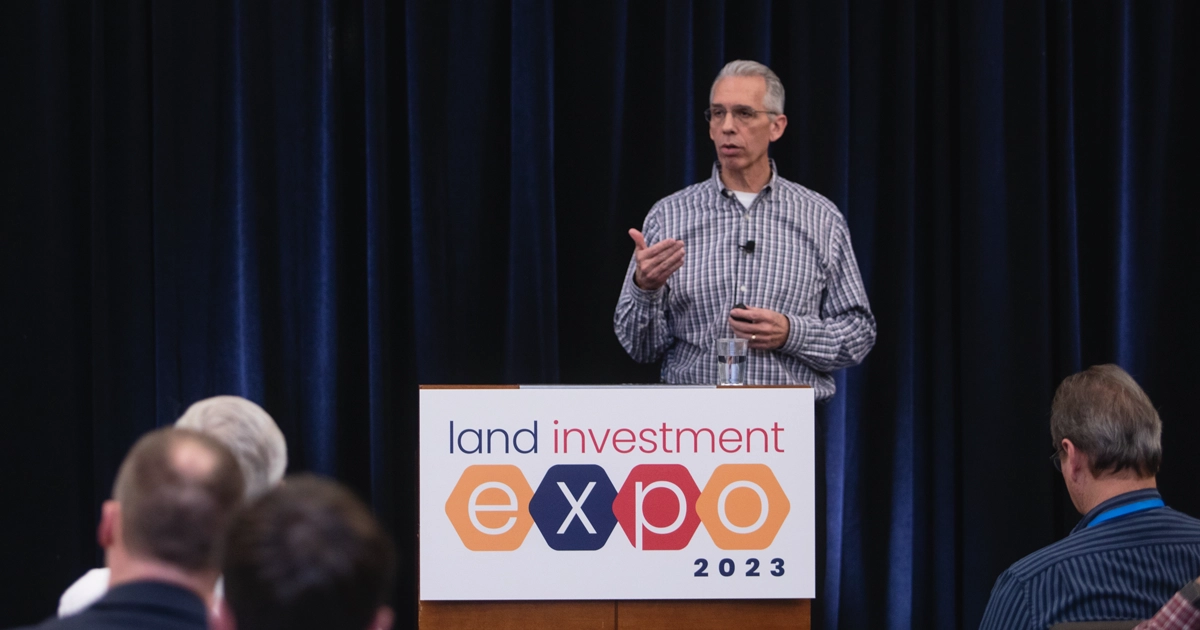2023 Farmland Forecast by Jim Knuth
2023 Farmland Forecast by Jim Knuth

LR_JimKnuth-01
There’s only one way to go when you’ve reached a peak — and that’s down. It’s an incontestable truth many US farmers may have to navigate in 2023, following last year’s record-high commodity returns.
Still, in his 2023 Land Investment Expo breakout session — aptly titled “Agriculture Looking Forward” — Farm Credit Services of America Senior Vice President Jim Knuth offered insights to help buffer potential market downturns that could define 2023.
US Grain Production: What Comes Next?
In 2023 and beyond, US grain producers will be “navigating the road from the peak,” Knuth said. That’s because, in his view, 2022 represented the apex of “the third supercycle of modern US grain production,” following previous peaks in the late 1970s and the ethanol-driven boom of the early 2000s.
Overall US net farm income reached all-time highs in the last two years, capping at $140 billion in 2021 and $148 billion in 2022. These record returns were spurred largely by grain profits and an influx of federal payment supports totaling $26 billion and $13 billion, respectively, during the last two growing seasons.
“If you were planting corn or soybeans in the last two years, your returns have been $500 to $700 an acre — our best, largest-ever margins per acre,” Knuth said. “The question mark, the unknown, going forward, is how steep or how gradual the road downward from those peak returns will be.”
A Margin Squeeze Is Coming
The booming commodities market has flushed unprecedented levels of working capital into the US agriculture market.
“Grain production agriculture is on very solid financial footing,” Knuth said, noting that 25 percent of the producers in Farm Credit Services’ current portfolio currently have no need to borrow assets to put their crops in. They’re operating entirely on cash.
While recent ag markets have been shaped by this unprecedented liquidity — and therefore higher short-term risk-taking thresholds — Knuth believes a “margin squeeze” is coming in 2023.
Nonetheless, there’s good news for grain farmers: profits are still attainable.
“I want to make clear that we believe the coming year will [still] be very profitable for grain production agriculture,” Knuth clarified. “But we will — more than likely — not enjoy those record-margins [of 2021 and 2022], and costs and other issues will start to squeeze our margins.”
The session made it clear farmers should brace for market shifts that may be on the horizon.
“I’d say 2023 is good time to have both hands on the wheel,” Knuth said. “Our margin of error is going to be narrower, and it’s going to take good financial planning, good business acumen, and probably proactive marketing” to maximize profitability.
Financing Trends in US Agriculture
With rising interest rates, loan institutions are now unable to finance as much debt per acre as they had previously. Lenders might have felt comfortable financing $5,000 in debt or more per acre when prime interest rates were below 5 percent. But now that the current prime rate is hovering around 7.5 percent, that figure is more likely to be less than $4,000 per acre, Knuth said.
“While land values have continued to increase, the amount of debt per acre that we can finance and still have a long-term sustainable payment plan has actually decreased, due to rising interest rates,” he explained. “What’s the net effect? More cash, more collateral is required to go into these purchases.”
Interest rates will remain “the wild card for the whole year,” Knuth projected. He told the breakout session’s standing-room-only crowd that he believed short-term interest rates might rise moderately in the first half of the year, while long-term rates will remain relatively stable.
For generations, a trusted lending rule of thumb has been this: farmers can afford to allocate somewhere between 30 and 35 percent of gross farm income to debt repayment. That metric still rings true today, Knuth said.
But, in the wake of recent booming ag markets, lenders need to be on guard. “Historically, most lending and credit mistakes are made at the top of cycles,” Knuth shared. Instead, lenders should make it their goal to be “conservative in good times, so that they can be courageous and reliable in tough times,” he said.
Ag Investments Going Forward
For growers looking to finance additional land or ag-based purchases in the coming year, Knuth offered these recommendations:
- Realize that a decline in commodity prices, if it happens, will likely precede a decline in supply costs – so plan to have operational adjustments in place, if needed.
- Make it a priority to maintain your liquidity. Don’t pay cash for everything. Use appropriate financing opportunities to protect your short-term risk-taking ability. Focus on retaining working capital, since restructuring debt for stressed operations will be more difficult in a climate marked by higher interest rates.
- If margins do become squeezed, identify logistical adjustments you can take to ensure you still secure your revenue targets.
As farmers navigate the way forward from the most recent grain boom, Knuth encouraged producers to learn from past ag cycles. “The three questions we had to answer following the last grain boom cycle – What are my costs? What are my break-evens? And, is it sustainable? – are the same three questions we may have to ask again,” he said.



